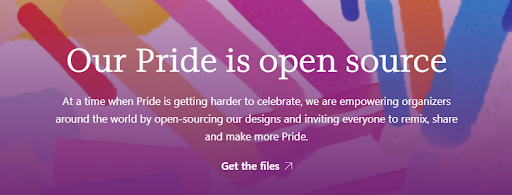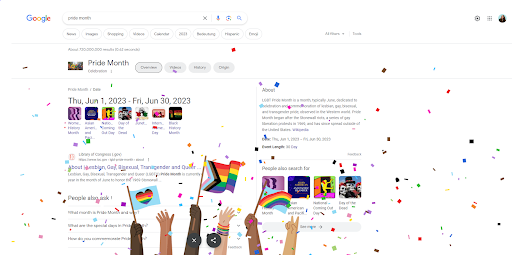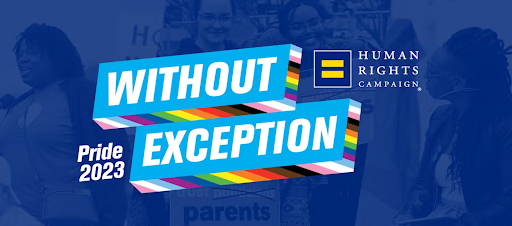If you’re active on just about any social media platform, you’ve noticed your feed has been transformed into a kaleidoscope of color in honor of Pride Month.
The very first Pride march in New York City was held June 28, 1970, commemorating the 1-year anniversary of the Stonewall Uprising. Now, flash forward over 50 years: The month-long holiday has been officially recognized by 3 U.S. presidents and countries worldwide, all in celebration of the global LGBTQ+ community.
Wondering where brands fit into this story? It’s a fair question. For the past several years, companies have started inserting themselves into Pride, “rainbow-fying” their online presence in celebration of the month. However, as we’ll learn in just a moment, there’s a big difference between changing your logo for 30 days versus showing authentic, year-round support.
Today, we’re breaking down examples of some of the best corporate Pride campaigns — and how you can ensure your company makes the list next year.
A Brief History Lesson: Carrying the Torch for Cause-Related Marketing
Pride comes in every color under the rainbow, so it makes sense that each campaign won’t look exactly the same. That said, almost every example we’re about to see shares a common theme, separating the good and the great (as well as the not so great): cause-related marketing.
At its most basic, cause-related marketing is a beneficial collaboration between a corporation and a nonprofit designed to promote the former’s sales and the latter’s cause.
Think of it as the ultimate win-win scenario. On one hand, your brand is able to support a cause that means a lot to both your target audience as well as your team members. On the other, you also have an opportunity to demonstrate that not only do you talk the talk, but you most certainly walk the walk when it comes to your values.
American Express first coined the term cause-related marketing in 1983 to describe its campaign to raise money for the Statue of Liberty’s restoration, as reported by The New York Times. The company donated 1 cent to the restoration every time someone used its charge card, raising over $1.7 million for the Restoration Fund — boosting card usage by 27% and seeing a 45% increase in applications the year following.
40 years after American Express’ first trial run, cause-related marketing is still a mainstay for modern brands. However, with today’s savvy consumers, understanding how to execute this strategy while still remaining authentic and genuine is more important than ever before.
Subscribe to
The Content Marketer
Get weekly insights, advice and opinions about all things digital marketing.
Thank you for subscribing to The Content Marketer!
5 Examples of Well-Done Pride Campaigns
Now, there’s no documented instance of the first company to do Pride “right.” Business-to-consumer (B2C) brands like Subaru and Absolut Vodka have had a long and storied history within the LGBTQ+ community starting as early as the 1980s. As consciousness shoppers, we’ve grown accustomed to — if not weary of — an uptick in rainbow-themed products throughout the month of Pride (also known as rainbow capitalism).
The good news is that increasingly, marketers are learning from their predecessors’ past mistakes. Within the past decade, more and more brands have been joining Pride for all of the right reasons — and not just jumping on the bandwagon.
As we recognize and celebrate the accomplishments of the LGBTQ+ community this June, let’s explore the companies that truly are setting the example for those to follow:
1. Microsoft’s Pride is Open-Source

This year, Microsoft’s Pride campaign takes multiple approaches, inviting everyone to “make and expand Pride.” Here are just a few things the company offers in 2023:
- Stories and perspectives from LGBTQIA+ employees at Microsoft.
- Open-source Pride assets.
- A unique Pride controller for Xbox consoles.
- Games with LGBTQIA+ creators, characters and stories.
If you’re looking for a way to put Pride into everything you do, this is it. Microsoft proves that you don’t have to build your campaign around any one sector or offering — and, in fact, you can tell more stories by creatively engaging with different parts of your audience.
2. Google Celebrates Learning
If you’ve typed a Pride-related query into your Google search bar lately, you may have noticed something interesting. There’s a fun animation that passes across your screen:

This may not be one of the most outspoken, powerful or influential campaigns out there, but it emphasizes Google’s role in educating the world about LGBTQ+ stories and issues. It also celebrates you in your effort to learn more about Pride.
On top of that, Google Trends tracks how the U.S. celebrates Pride by recording search patterns and frequencies in different areas. It’s a fascinating visualization of national conversations and how they evolve. (Hint: It’s also a great way to start researching keywords or topics for your own Pride content!)
The takeaway here is that bigger isn’t always better. A fun animation here or a few data points there can keep you relevant in your audience’s mind while they build their own experiences and celebrations.
3. IBM Shares Pride Year-Round
Even as more and more leaders place a priority on Diversity, Equity and Inclusion (DEI) initiatives, most brands’ Pride celebrations are still kept within the confines of the 30 days of June.
At IBM, that couldn’t be further from the truth.
IBM has participated in HRC’s Corporate Equality Index (CEI) since its inception in 2002. And, not only has the company received a perfect 100 score, but it has also been honored as being recognized as a leading “Best Place to Work for LGBTQ+ Equality” since 2003. However, accolades like this don’t just come from a month-long campaign.
IBM has a long history of championing the LGBTQ+ community both in and out of the workplace, partnering with dozens of non-profit organizations for research projects, fundraising events and the development of ongoing LGBTQ+ resources. As Chief Diversity and Inclusion Officer Tia Silas told Glassdoor in 2020:
“As early as 1984, [IBM] included sexual orientation in our non-discrimination policy. We continue promoting and defending LGBT+ rights around the world and actively influenced legislation and policy in Louisiana, North Carolina, and Texas. And over the past year, we have engaged in countries such as Northern Ireland, Taiwan, Israel and Japan to support marriage equality referendums.“
As they’ve done in previous years, IBM doesn’t plan to keep their Pride contained to just one month. They’ll fill all of 2023 with their commitment to creating an open, welcoming environment — and it starts with this vibrant landing page. Here, you’ll find insights into IBM’s mission and values, plus numbers, resources and interactive timelines to help everyone learn more. It’s an open, ongoing invitation to get involved on any day of the year.
For Pride this year, IBM is simply carrying on with what they do 365 days a year. Rather than a one-and-done initiative, June is seen as another opportunity to recognize and celebrate diversity within the company, highlighting these stories across all of IBM’s social media channels. And, although the tech company isn’t one for tooting its own horn when it comes to Pride, a quick skim of the IBM website shows just how deep its inclusive values run year-round.
4. The Human Rights Campaign Brings People Together
When a Pride campaign misses the mark, it’s often because a company is focused on itself instead of the people and communities it claims to support. Fortunately, that’s not an issue for the Human Rights Campaign (HRC) and their 2023 Pride celebration.

This approach is centered around the #WithoutException hashtag, allowing communities to come together to “thrive, spread joy and support queer spaces across the country.” There are plenty of opportunities for readers to get involved, with call-to-action (CTA) buttons reading “Act Now!” and “Sign the Pledge!” Aside from inspiring this sense of connectedness, HRC also provides more concrete support with guides, resources, influencer videos and more.
Keep in mind that, while there are opportunities to spend or donate money, this campaign isn’t about bringing attention to HRC itself. In fact, the landing page acts as more of a hub for content relevant to the LGBTQ+ community. In this way, HRC doesn’t talk about its audience; it talks right to them.
5. Pfizer: Thrive with Pride
While many brands are newcomers to all things Pride Month, Pfizer has been committed to the cause for over 16 years.
Since 2006, the pharmaceutical company has published its “Pride Journal,” a platform where LGBTQ+ Pfizer Colleagues and allies can share personal experiences of struggles, triumph and their hope for the future in honor of Pride Month.

Although the Pride Journal is public for all who are interested, the campaign is focused more directly on Pfizer’s internal audience, a major difference between its efforts and many other brands. While it can be tempting to dive headfirst into a fun, flashy and cause-related marketing campaign, sometimes the most powerful actions your brand takes during Pride start within your own 4 walls.
Showing Your Brand’s True Colors: Considerations for Your Pride Campaign
Stop me if this one sounds familiar: After showing off their support for Pride all June long, the clock strikes midnight on July 1 and suddenly, all of these loud and proud brands have reverted to business as usual.
What gives?
As Forbes reports, the LGBTQ+ community has an estimated combined buying power of $3.7 trillion. Yes, you read that correctly; trillion with a “t.” For better or for worse, this has inspired many businesses to slap a rainbow flag on their social media channels during Pride — most of whom promptly forget about the community as soon as July rolls around.
Today’s consumers are savvy. It only takes one glance for them to easily distinguish between brands that are authentic partners in the fight for equality (like those above) versus ones that are just trying to make a quick buck (think back to the rainbow-adorned grocery shelves). As we learned today, it’s essential to make it clear that your support of the LGBTQ+ community is not limited to just one month.
Whether you’re planning a Pride campaign for next year or are looking to take a more inclusive approach to your year-round marketing strategy, consider these tips:
- Bring representation into the meeting: If there isn’t a member of the LGBTQ+ community within your own team, it’s time to take a step back. Consider why that is, and how your company can leverage examples like Pfizer to better champion underrepresented voices within your organization.
- Partner with LGBTQ+ organizations: Your brand doesn’t have to go it alone. In fact, partnering with an existing organization and helping them to elevate their own platform can be far more powerful than building one of your own. Think like Tinder: Reflect on your company’s own values and look for causes that overlap with your overarching mission.
- Work toward real change: Whether it’s lobbying for a change in legislation, raising funds for a cause your team believes in or creating a platform for the LGBTQ+ community, think about the impact of your campaign. As we saw with Skittles, your actions will mean far more than the message.
Remember: The worst thing you can do this Pride is simply throw a colorful filter on your logo and call it a day. Instead, bring the same careful attention to detail you would to any marketing campaign. Consider your company’s values and how you can bring them to life through meaningful action. And, most importantly, don’t shed all of your rainbows come July 1.





